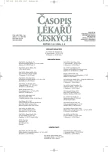-
Medical journals
- Career
Treatment of the Unresectable Non Small Cell Lung Carcinoma
Authors: I. Špásová
Authors‘ workplace: Pneumologická klinika 2. LF UK a FNM, Praha
Published in: Čas. Lék. čes. 2005; 144: 602-612
Category: Review Article
Overview
In recent years, treatment of the locally advanced unresectable Non Small Cell Lung Cancer (NSCLC) has evolved from the radiotherapy alone to sequential therapy settings with induction chemotherapy followed by radiotherapy. During recent years, concomitant chemoradiotherapy has become the standard treatment for these patients. The addition of chemotherapy during the course of radiotherapy provides better locoregional control of the disease by killing the radioresistant cells, inhibition of the reparation processes in the sublethally damaged cells and accumulation of the cells in the G₂/M phase, when the cells are sensitive to radiation. It also reduces the spread of the micrometastases. Administration of cisplatin-based regimens appears to be the most effective. Acute pneumonias can be effectively suppressed by amifostine administration. Locally advanced inoperable NSCLC can be cured by chemoradiotherapy in more than 10% of patients. Fractionation radiotherapy does not yield prolonged survival. Currently the other clinical studies investigating the effects of hyperfractionation, 3D conformal radiotherapy and IMRT (intense modified radiotherapy) are being conducted. Also the role of various radiosensitizing agents is currently under clinical evaluation. The results of a study, comparing various doublet combinations of taxanes and gemcitabine with cisplatin or carboplatin demonstrate, that as for the efficacy, the standard doublet regimens reached a certain plateau and that they prolong the survival in comparison with the standard regimens used before 1990. The only statistically significant difference in the efficacy among the individual treatment arms is the significantly longer time to the progressive disease in the arm treated by gemcitabine and cisplatin. Studies with triplet regimens show that the addition of the third cytotoxic agent might increase the overall response rate with the increase of toxicity and only a very small survival benefit. The replacement of the platinum derivate by some of the new cytotoxic agents does not appear to yield lower efficacy and also shows a more favorable toxicity profile; it is, however, significantly more expensive. Overall differences among the cytostatic combinations based on cisplatin in comparison with combinations based on carboplatin are not very distinct. Nevertheless, the combination of cisplatin with third generation cytotoxic agents is recommendable as it is more effective for patients with advanced NSCLC without renal impairment and with adequate bone marrow reserve. A high percentage of patients with NSCLC are older that 70 and this percentage will increase further. Earlier, chemotherapy was not used for these patients with the explanation that elderly people are usually polymorbid and the function of their organs which metabolize the cytostatics is reduced. However, a survival benefit in elderly patients treated by cytotoxic monotherapy was proven in comparison with the best supportive care. Other studies, however, found significant differences neither in toxicity nor in survival in comparison with younger patients, when using the same treatment regimens. Platinum doublets, based namely on carboplatin, are useful for patients older than 70, who are in good clinical condition. In the second-line therapy of NSCLC pemetrexed demonstrates identical efficacy as docetaxel, which is considered as a standard monotherapy in the second-line treatment of NSCLC. Moreover, pemetrexed is associated with less toxicity. These data show that in future, pemetrexed may become the standard treatment for second-line therapy of NSCLC. In patients with stage IIIB/IV of NSCLC, the addition of biological treatment to standard doublet cytostatic combination does not bring any survival benefit. In future, more detailed attention should be paid to selection of the patients for this treatment modality. When comparing survival time by meta-analysis, significantly longer survival time of the patients treated with gemcitabine combination was found in comparison with other treatment. Similarly, the progression-free survival is significantly longer in the patients treated with gemcitabine containing regimen. This data has proven good clinical efficacy of gemcitabine in the first-line therapy of advanced NSCLC.
Key words:
advanced non-small cell lung cancer, NSCLC, chemotherapy, chemo-radiotherapy, phase III trials, meta-analysis.
Labels
Addictology Allergology and clinical immunology Angiology Audiology Clinical biochemistry Dermatology & STDs Paediatric gastroenterology Paediatric surgery Paediatric cardiology Paediatric neurology Paediatric ENT Paediatric psychiatry Paediatric rheumatology Diabetology Pharmacy Vascular surgery Pain management Dental Hygienist
Article was published inJournal of Czech Physicians

-
All articles in this issue
- Tuberculosis in the Czech Republic in the Year 2004
- Shared Pathogenesis of Infectious and Cardiovascular Diseases – Year 2005´s View
- The Risk of Malignancy After Organ Transplantation
- Treatment of the Unresectable Non Small Cell Lung Carcinoma
- Role of Intestine in Immunity Mechanisms
- Intestinal Ischemia Represents Serious Surgical Problem
- Percutaneous Vertebroplasty
- Neuronal Network
- Differential Diagnosis of Peripheral Neuropathy
- Bortezomib (Velcade) in Relapsed/Refractory Multiple Myeloma The First Experience in the Czech Republic
- Latex Allergy – Report on Two Cases
- Czech Medical Doctors and World No Tobacco Day on May 31, 2005
- From the History of Endocrinology: Reminiscence of the Discovery of Adrenocortical Hormones
- Journal of Czech Physicians
- Journal archive
- Current issue
- Online only
- About the journal
Most read in this issue- Latex Allergy – Report on Two Cases
- Differential Diagnosis of Peripheral Neuropathy
- From the History of Endocrinology: Reminiscence of the Discovery of Adrenocortical Hormones
- Intestinal Ischemia Represents Serious Surgical Problem
Login#ADS_BOTTOM_SCRIPTS#Forgotten passwordEnter the email address that you registered with. We will send you instructions on how to set a new password.
- Career

